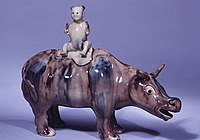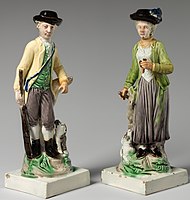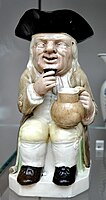| This article includes a list of general references, but it lacks sufficient corresponding inline citations. Please help to improve this article by introducing more precise citations. (December 2015) (Learn how and when to remove this message) |

The Wood family was an English family of Staffordshire potters. Among its members were Ralph Wood I (1715–1772), the "miller of Burslem," his son Ralph Wood II (1748–1795), and his grandson Ralph Wood III (1774–1801). Ralph I was the brother of Aaron Wood, father of Enoch Wood. Through his mother, Ralph Wood II was related to Josiah Wedgwood.
The first two Ralphs were among the best modellers in Staffordshire pottery of their day, both mainly noted for their Staffordshire figures, as well as running successful "potbank" businesses. Their most popular figures continued to be produced well after their deaths, and were often imitated and copied by others. Aaron Wood was also an important modeller, but more noted for "useful" tablewares.
Ralph Wood I
Ralph Wood I (1715–1772) was apprenticed to John Astbury in 1730, then worked with Thomas Whieldon at Fenton Low where he learned to make coloured glazes. In 1754 he started making his own salt-glazed wares at Burslem, and by about 1760 was creating ceramic figures of humans and animals, mostly famously stags. He is credited with introducing the Toby jug, with his first being "Toby Philpot" circa 1762. He supplied Wedgwood with some models.
Experts have become more cautious in attributing individual pieces to his pottery, and many are now described by terms such "Whieldon-type".
-
 Water buffalo with boy, one of a pair, c. 1750, tortoiseshell ware
Water buffalo with boy, one of a pair, c. 1750, tortoiseshell ware
-
St. George and the Dragon, attributed, 1760s
Ralph Wood II
Ralph Wood II (1748–1795) followed in his father's footsteps, manufacturing a variety of figures coloured with overglaze enamels; at least some were supplied to Josiah Wedgwood in 1782 and 1783. The details of his career have been the subject of considerable controversy in recent decades. From 1773 to 1781 he ran a shop in Bristol, whose assets were sold when he went bankrupt. His brother John worked with him, apparently running things in Burslem at least some of this time.
He also employed the mysterious figure of John Voyez, who Wedgwood had dismissed and then prosecuted either for theft of designs, or for being caught drawing the daughter of another employee in the nude (perhaps acceptable in France, but not in Staffordshire). In any case he received a prison sentence in Stafford Goal in 1769. Voyez seems to have been French and trained in some form of sculpture, and probably modelled many of the figures. His work is associated with "thick-lidded eyes, somewhat flattened noses, and a general roundness of contour", and "somewhat pugnatious facial details on almost all his figures, even those representing women".
On 24 June 1774, he married Sophia Lambert and their son, Ralph Wood III, was baptized on 29 May 1774.
-
 Fox and goose sauceboat, 1770s
Fox and goose sauceboat, 1770s
-
 William III as a Roman emperor, 1770s. Lead-glazed earthenware, 14 inches
William III as a Roman emperor, 1770s. Lead-glazed earthenware, 14 inches
-
 Sportsman and sportswoman, c. 1780
Sportsman and sportswoman, c. 1780
-
 Diana with hound, 1780s
Diana with hound, 1780s
-
 Pearlware Toby jug, c. 1782–1795
Pearlware Toby jug, c. 1782–1795
Ralph Wood III
Ralph Wood III (1774–1801) continued the Hill Potworks until his early death in 1801, at which time production of Ralph Wood figures ceased. It is not clear if he modelled himself, or even introduced new figures.
Notes
- "Wood Family". Encyclopædia Britannica. Encyclopædia Britannica, inc. 20 July 1998. Retrieved 27 July 2019.
- Avery, 128
- Avery, 128 (quoted); Elliott, 6-7
- Elliott, 7
References
- Avery, C. Louise, "The Tithe Pig", The Metropolitan Museum of Art Bulletin, vol. 32, no. 5, 1937, pp. 127–129. JSTOR, Free PDF
- Elliott, Gordon, Aspects of Ceramic History: A Series of Papers Focusing on the Ceramic Artifact As Evidence of Cultural and Technical Developments, Volume 1, 2006, Gordon Elliott, ISBN 0955769000, 9780955769009, online
- Wood Family (Encyclopædia Britannica)
- My Staffordshire Figures (biography)